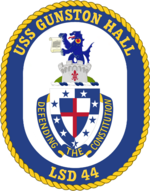
USS Peleliu (LHA-5) is a Tarawa-class amphibious assault ship of the United States Navy, named for the Battle of Peleliu of World War II. Entering service in 1980, she has been deployed to the Persian Gulf on several occasions, performed an evacuation of U.S. Naval Base Subic Bay following the eruption of Mount Pinatubo, operated with the INTERFET peacekeeping taskforce, participated in Pacific Partnership deployments, and provided assistance following the massive floods in Pakistan in 2010. She was decommissioned in San Diego, California on 31 March 2015. She currently rests, out of commission and in reserve, at NAVSEA Inactive Ships On-site Maintenance Office, Pearl Harbor, Hawaii alongside USS Tarawa in the inactive reserve in case of further need.

USS Tarawa (LHA-1), the lead ship of her class, is an amphibious assault ship that served in the United States Navy from 1976 to 2009. She is the second ship to be named for the Battle of Tarawa, fought during World War II. Tarawa was decommissioned on 31 March 2009, at San Diego Naval Base.

USS Trenton (LPD-14), an Austin-class amphibious transport dock, was the third ship of the United States Navy to be named for the capital of New Jersey. In 2007, it was sold to the Indian Navy and renamed INS Jalashwa.

USS Duluth (LPD-6), an Austin-class amphibious transport dock, is the second ship of the United States Navy named for the city in Minnesota.

USS Cleveland (LPD-7), an Austin-class amphibious transport dock, was the third ship of the United States Navy to be named for the city in Ohio. Her keel was laid down at Ingalls Shipbuilding of Pascagoula, Mississippi. She was launched on 7 May 1966, and was commissioned on 21 April 1967 at Norfolk, Virginia. At the time of decommissioning, she was the third-oldest commissioned ship in the US Navy, behind USS Constitution and USS Enterprise.

USS New Orleans (LPD-18), a San Antonio-class amphibious transport dock, is the fourth commissioned ship of the United States Navy to be named after the city of New Orleans, Louisiana.

USS Essex (LHD-2) is a Wasp-class Landing Helicopter Dock (LHD) in service with the United States Navy. The amphibious assault ship was built at what is now Huntington Ingalls Industries in Pascagoula, Mississippi. She was launched 23 February 1991 and commissioned on 17 October 1992 while moored at Naval Air Station (NAS) North Island. She is the fifth ship named for Essex County, Massachusetts. Essex served as the command ship for Expeditionary Strike Group Seven until replaced by USS Bonhomme Richard on 23 April 2012.

USS Nassau (LHA-4) was a Tarawa-class amphibious assault ship. When active, she was capable of transporting more than 3,000 United States Navy and United States Marine Corps personnel. Ingalls Shipbuilding in Pascagoula, Mississippi, laid the ship's keel on 13 August 1973; she was commissioned on 28 July 1979. She was decommissioned on 31 March 2011.
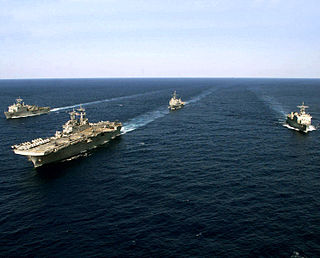
An amphibious ready group (ARG) of the United States Navy consists of a naval element—a group of warships known as an Amphibious Task Force (ATF)—and a landing force (LF) of U.S. Marines, in total about 5,000 people. Together, these elements and supporting units are trained, organized, and equipped to perform amphibious operations.
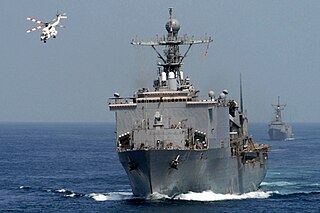
USS Whidbey Island (LSD-41) is a Whidbey Island-class dock landing ship (LSD) of the United States Navy. She was named for Whidbey Island, in Puget Sound, Washington, the location of NAS Whidbey Island; the name ultimately derives from the sailor, explorer and engineer Joseph Whidbey.

USS Fort McHenry (LSD-43) is a Whidbey Island-class dock landing ship of the United States Navy. She was named for Fort McHenry, in Baltimore, Maryland, the 1814 defense of which inspired "The Star-Spangled Banner".

USS Rushmore (LSD-47) is a Whidbey Island-class dock landing ship of the United States Navy. She was the second navy ship to be named for the Mount Rushmore National Memorial in the Black Hills of South Dakota. She is the seventh ship in her class of dock landing ships and the fourth ship in that class to serve in the United States Pacific Fleet.

USS Carter Hall (LSD-50) is a Harpers Ferry-class dock landing ship of the United States Navy. She is the second US Navy ship to be named for Carter Hall, an estate near Winchester, Virginia, built in the 1790s.
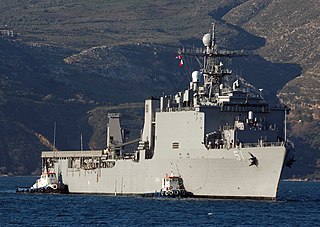
USS Oak Hill (LSD-51) is a Harpers Ferry-class dock landing ship of the United States Navy. She is named in honor of Oak Hill, the residence of James Monroe, the fifth president of the United States. The Monroe Doctrine was penned at Oak Hill, and subsequently delivered at an 1823 congressional address which asserted that the Western Hemisphere was never to be colonized again. This doctrine is the inspiration for the ship's motto: Nations' Protector. Oak Hill is the second ship to honor the residence.

USS Arlington (LPD-24), a San Antonio-class amphibious transport dock, is the third ship of the United States Navy to be named for Arlington County, Virginia, the location of the Pentagon and the crash site of American Airlines Flight 77 during the terrorist attacks on 11 September 2001. Like her sister ships, USS New York and Somerset, she is named in commemoration of the attacks. Steel taken from the Pentagon after the attacks is displayed aboard in the ship's museum.
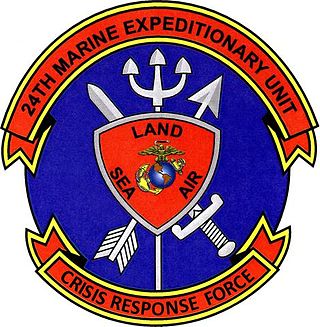
The 24th Marine Expeditionary Unit is one of seven Marine Expeditionary Units currently in existence in the United States Marine Corps. The Marine Expeditionary Unit is a Marine Air Ground Task Force (MAGTF) with a strength of about 2,200 personnel. The MEU consists of a Command Element, a Ground Combat Element based on a reinforced infantry battalion, an Aviation Combat Element based on a reinforced tiltrotor squadron, and a Logistics Command Element based on a Combat Logistics Battalion. The 24th MEU is currently based out of Marine Corps Base Camp Lejeune, North Carolina.

The 22nd Marine Expeditionary Unit is one of seven such units currently in existence in the United States Marine Corps. It is a Marine Air Ground Task Force with a strength of about 2,200 personnel. They are currently based out of Marine Corps Base Camp Lejeune, North Carolina and fall under the command of the II Marine Expeditionary Force. It is the most decorated of the U.S. Marine Corps' seven MEUs.

The 31st Marine Expeditionary Unit is one of seven Marine Expeditionary Units in existence in the United States Marine Corps. The Marine Expeditionary Unit is a Marine Air Ground Task Force with a strength of about 2,200 Marines and sailors. The 31st MEU consists of a company-sized command element, a battalion landing team (BLT),, a medium tiltrotor squadron (reinforced),, and a combat logistics battalion. The 31st MEU is based at Camp Hansen, Marine Corps Base Camp Smedley D. Butler, Okinawa, Japan. The 31st MEU is the only permanently forward-deployed MEU, and provides a flexible and lethal force ready to perform a wide range of military, humanitarian, and diplomatic operations as the premier crisis response force in the Indo-Pacific region.
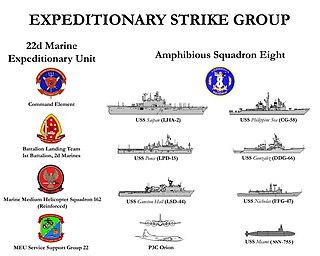
In the United States Navy, the expeditionary strike group (ESG) is a coordinated group of surface ships, aircraft, submarines, and other naval assets. In contrast to carrier strike groups (CSGs), which emphasize air power and are led by a supercarrier, ESGs are strongly suited for amphibious warfare and are led by an amphibious assault ship. The ESG concept was introduced in the early 1990s, based on the Naval Expeditionary Task Force. The U.S. Navy fields nine expeditionary strike groups.

Expeditionary Strike Group SEVEN/Task Force 76 is a United States Navy task force. It is part of the United States Seventh Fleet and the USN's only permanently forward-deployed expeditionary strike group. It is based at the White Beach Naval Facility at the end of the Katsuren Peninsula in Uruma City, Okinawa, Japan.

